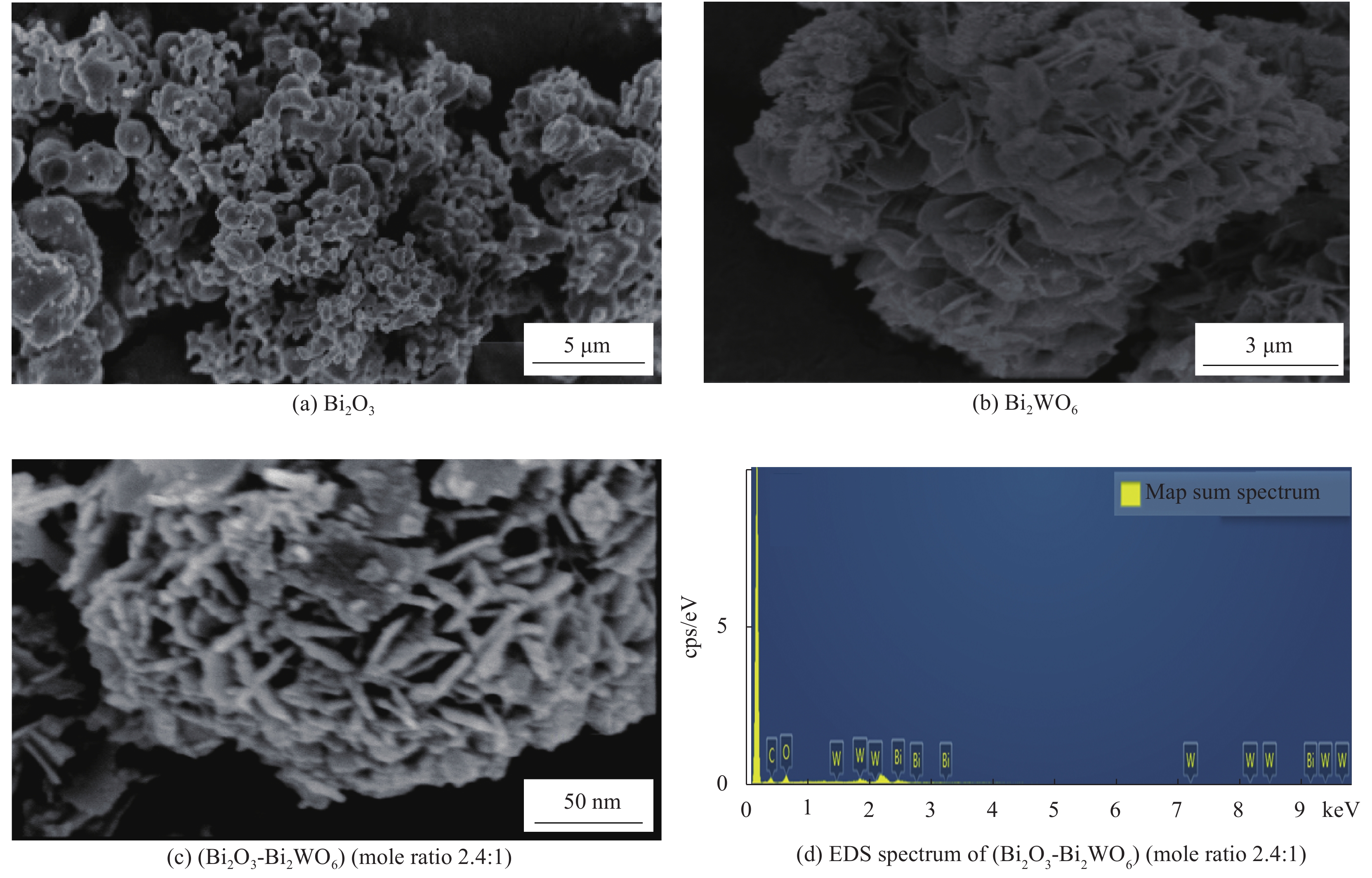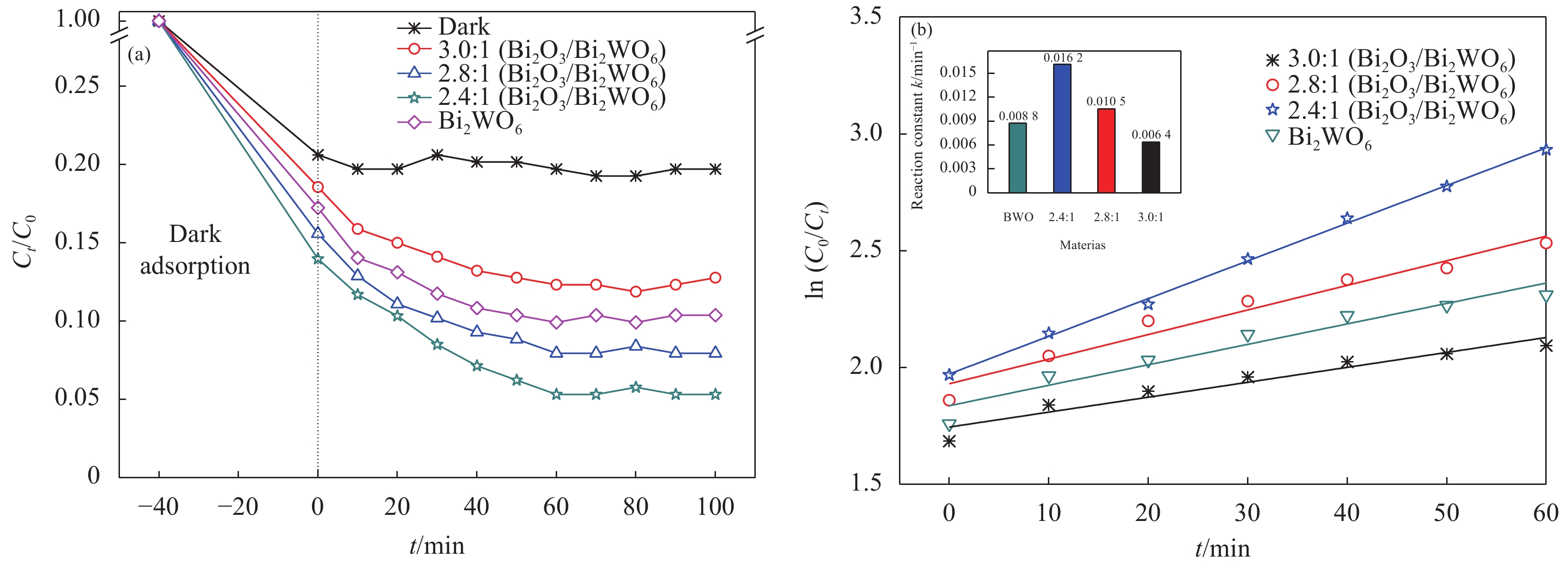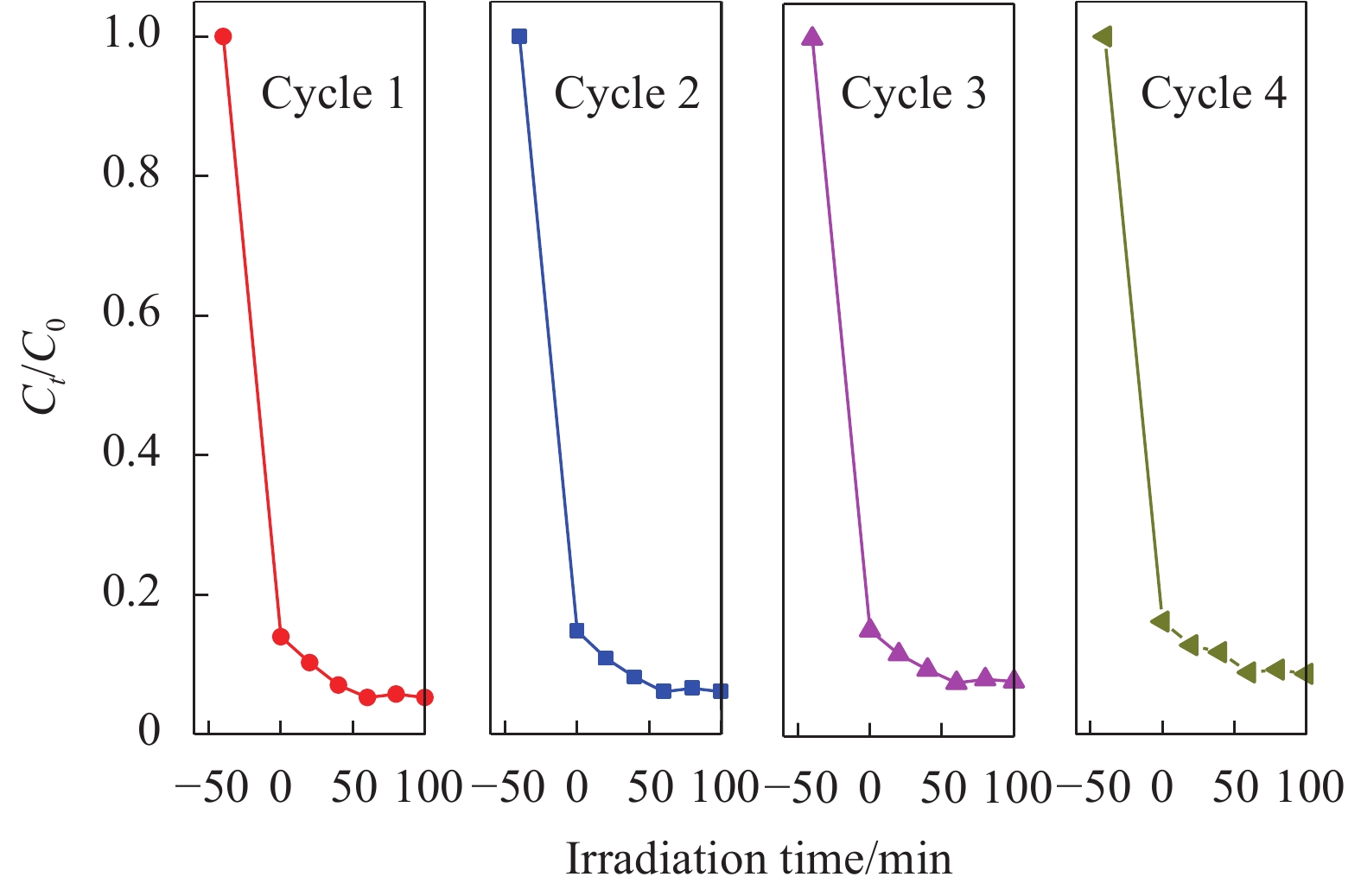Preparation and characterization of Bi2O3-Bi2WO6 direct Z-scheme heterojunction and photocatalytic reduction of U(VI) under visible light irradiation
-
摘要: 根据能带理论,以Bi(NO3)3·5H2O为铋源,采用水热煅烧法制备了Bi2O3-Bi2WO6复合光催化材料,SEM、XRD、XPS、紫外可见漫反射(UV-vis DRS)、电化学阻抗(EIS)等表征手段对材料进行表征与分析,以U(VI)为目标污染物,在可见光下进行光催化还原U(VI)的性能研究。结果表明:与纯Bi2WO6相比,Bi2O3-Bi2WO6复合材料具有较高的光催化活性,当Bi2O3与Bi2WO6的摩尔比为2.4∶1时,Bi2O3-Bi2WO6的光催化活性最好,光催化活性增强归因于Bi2O3的加入,在Bi2O3与Bi2WO6界面形成的直接Z-scheme异质结,提高了光生电子-空穴的传输速率,降低了其复合率;另一方面,Bi2O3的加入使Bi2WO6带隙变小,扩大对可见光的响应范围,从而提高了Bi2O3-Bi2WO6光催化剂的活性。本研究为设计和合成具有高可见光活性的光催化剂和了解增强U(VI)光催化还原机理提供了新的思路。
-
关键词:
- 钨酸铋 /
- 直接Z-scheme异质结 /
- 光催化 /
- 还原 /
- 铀
Abstract: According to the energy band theory, Bi(NO3)3·5H2O was used as bismuth source to synthesize Bi2O3-Bi2WO6 composite photocatalyst materials by hydrothermal calcination. The samples were characterized by means of SEM, XRD, XPS, DRS and EIS, respectively, and the photocatalytic activity was assessed in terms of reduction of U(VI) under visible light irradiation. The results show that the prepared Bi2O3-Bi2WO6 composite materials exhibit enhanced photocatalytic performance for the photo-reduction of U(VI) than the pure Bi2WO6, the optimized photocatalytic efficiency for U(VI) is achieved when the mole ratios of Bi2O3 to Bi2WO6 is 2.4∶1. The improved photocatalytic activity is ascribed to the direct Z-scheme heterojunction between Bi2O3 and Bi2WO6, resulting in the rapid interfacial transfer of photoelectron-hole and wide light response range. This work provides a new idea to design and synthesize the photocatalysts with high visible light activity and understand the enhanced photocatalytic reduction mechanism of U(VI).-
Keywords:
- bismuth tungstate /
- direct Z-scheme heterojunction /
- photocatalysis /
- reduction /
- uranium
-
随着能源的日益枯竭和环境污染问题日益严峻,迫切需求采取节能减排措施[1]。在能源总消耗中,约有1/3用于建筑领域,而其中一半的建筑能耗用于空调和供暖。门窗是室内外能量交换的主要途径。因此,通过窗口调节室内温度是降低建筑能耗的可行途径。
在20世纪80年代,Granqvist首次提出“智能窗”(Smart window)概念,指的是一种调光材料与玻璃等基材结合构成的节能窗户。这种窗户利用调光材料对各种物理刺激(如光、电、气、热等)的响应,导致其光学性质(透射率、反射率、吸收率等性能)发生变化,从而实现对室内环境温度的可控调节。根据变色机制的不同,智能窗可分为电致变色[2-5]、热致变色[6-7]、气致变色[8-9]和光致变色[10-12]等。其中,热致变色智能窗可根据环境温度的变化自动调整太阳光透过率,且无能源消耗,因此成为当前研究的焦点。
二氧化钒(VO2)是一种典型的热致变色材料[7, 13-14],其在图1中展示了在68℃(340 K)相变温度下发生的金属相-绝缘相的可逆相变(MIT)[15]。
为了全面描述VO2(M/R)的相变过程,通常会考虑晶体场理论的分子图,该理论由Goodenough[16]于1971年首次提出。如图1所示,VO2(R)的能带宽度约为2.5 eV,未填充的π和d//带部分重叠,费米能级(Ef)在π和d//带重叠时下降,表现出金属的特性。随着温度的降低,d//键分裂为d键和反键,π*键和d//键之间形成了0.7 eV的带隙,形成了绝缘相。
在低温下,它呈现单斜相结构的绝缘相,当温度升至68℃以上时,绝缘相转变为高温金属相,晶体结构从单斜转变为四方金红石结构。在此过程中,对近红外光的透射率从高变为低,而对可见光的透射率几乎没有明显变化。因此,VO2不仅能够调节室内温度,还能保持室内一定的明亮度,使其成为最理想的智能窗材料之一。
1. VO2智能窗性能评价指标
评估VO2智能窗性能有多个指标,包括相变温度(Tc)、可见光透射率(Tlum)、太阳调制能力(∆Tsol)和稳定性等。在这些指标中,热致变色性能(Tlum、∆Tsol)和稳定性是评估VO2智能窗性能的关键参数。本文总结了这些关键指标的计算方法,以便对VO2智能窗进行客观而全面的评估。
1.1 光学性能
VO2薄膜光学性能的计算基于其紫外-可见-近红外(UV-Vis-NIR)透射光谱[17]。Tlum(λ1–λ2)和∆Tsol(λ3–λ4)的计算公式如下:
Tlum, sol =∫φlum, sol(λ)T(λ)dλ∫φlum, sol(λ)dλ (1) ΔTsol =Tsol (25∘C)−Tsol (90∘C) (2) 其中:λ为波长,λ1–λ2为可见光的波长范围,λ3–λ4为紫外-可见-近红外光的波长范围;T(λ)为λ波长处的透过率值;φlum(λ)为人眼视觉敏感度,代入公式(1)所得为Tlum;φsol(λ)为距地平线37°、大气质量数为1.5时的太阳辐照光谱,代入公式(1)所得为Tsol。Tsol(25℃)为VO2绝缘相时Tsol;Tsol(90℃)为VO2金属相时Tsol。
1.2 稳定性
对于VO2环境稳定性的评估,采用高温、高湿的加速老化方法作为标准测试手段,以获取可靠而客观的结果。为建立测试数据与实际使用寿命之间的可靠关系,使用Hallberg-Peck加速模型进行模拟计算。
AF=exp[Eak(1Tuse −1Ttest )](RHtest RHuse )n (3) 其中:AF为加速因子;Ea为活化能(eV),VO2的活化能为0.7 eV;玻尔兹曼常数k为8.617×10−5 eV/K;n是湿度的加速速率常数,不同的类型对应不同的值,一般在2到3之间;Tuse和Ttest分别是工作温度(K)和加速度测试温度(K);RHuse和RHtest分别是工作湿度和加速测试湿度。
为满足智能窗实际应用的需求,研究者们在提高二氧化钒薄膜的可见光透射率(Tlum)、增大VO2薄膜的太阳调制能力(∆Tsol)、降低VO2薄膜的相变温度(Tc)及提高其稳定性等方面进行了大量研究。然而,关于VO2基复合结构薄膜的综述目前还相对较少。本文综述了VO2基复合结构薄膜的制备方法及性能提升策略的研究进展,并最后对智能窗用VO2基复合结构薄膜未来的发展方向进行了展望。
2. VO2纳米颗粒基复合结构
首先,制备VO2纳米颗粒是必要的,如图2(a)、图2(b)所示[18-19]。水热法是最常用的VO2纳米颗粒制备方法之一。该方法在高温高压环境下通过化学反应进行,可获得具有粒径分布窄、团聚程度低、晶格完整、较高纯度的粉体。水热法在制备过程中污染较小,能耗较低,是在相对较低温度下获得VO2纳米颗粒的有效途径。制备VO2纳米颗粒的水热法主要使用V2O5、NH4VO3和VOSO4等作为钒源,以及H2C2O4、H2O2和N2H4·H2O等作为还原剂,在高压环境下进行氧化还原反应。水热法的VO2纳米颗粒制备通常包括两步法和一步法。中国科学院合肥物质科学研究院李广海课题组的专利[20-21]采用类似的水热合成方式,首先制备VO2(B)或VO2(D)粉体,然后在高温下转变为VO2(M)粉体。Popuri等[18]以V2O5和柠檬酸为先驱体,采用一步水热法成功制备了VO2(B),180℃仅需2 h、220 ℃仅需1 h。并且制备出的VO2(B)在真空中550℃反应1 h即可得到VO2(M),如图2(a)所示。中国科学院上海硅酸盐研究所高彦峰教授课题组[22]首次采用V2O5、H2C2O4和少量的掺杂剂H2WO4为原料,一步水热制备了VO2(M)粉体。Alie等[23]以V2O5和H2C2O4为前驱体,通过调控前驱体的摩尔比、浓度、合成温度和时间等参数,直接采用水热法合成了具有热致变色特性的VO2(M)粉体。
2.1 VO2核壳结构
由于表面效应和离子间的范德华力等因素,纳米颗粒在溶液中容易发生团聚,难以实现单一纳米颗粒的分散。为了获得单分散的纳米颗粒,新兴的核壳结构应运而生。核壳结构以其改性性能而著称,通过外层的保护,能够显著提高VO2纳米颗粒的分散性和稳定性。
2.1.1 无机壳层结构
形成VO2核壳结构的方法涉及将不同材料与VO2结合,其中有一些稳定的透明氧化物材料,如TiO2[24]、SiO2[25]、SnO2[26]和ZnO[27],被用作保护外壳,从而强化VO2基复合结构薄膜的热致变色性能以满足实际应用需求。
VO2核壳结构的制备通常采用溶胶凝胶包覆法,即在溶液中首先形成溶胶或凝胶,然后用于包覆VO2纳米颗粒。Li等[28]采用错配应变异质外延法,以钛酸四丁酯(TBOT)为原料,在VO2表面包覆TiO2,成功制备了VO2@TiO2纳米颗粒,并对其热致变色性能进行了研究。此外,Li等[26]还报道了一种方法,水热法合成VO2纳米颗粒,溶胶-凝胶法制备TiO2前驱体涂层,并通过严格控制真空退火法制备TiO2外壳,从而制备出VO2@TiO2纳米棒。如图2(c)、图2(d)所示,首先在80℃条件下通过回流冷凝器进行2 h的溶胶-凝胶反应,使TBOT水解并沉淀到VO2纳米棒表面,然后进行过滤和收集。接着,将干燥后的粉末放入真空石英管中,在适当的温度和压力下进行退火,使外壳转化为TiO2晶体。
VO2的核壳结构还可以采用异相成核法,例如采用均匀沉淀法制备ZnS和CdS,在其生成过程中在VO2表面异相成核,形成包覆在VO2表面的结构。
Xie等[29]在研究中采用了有效介质理论和转移矩阵法,以探讨壳层材料的光学常数对光学性能的影响。结果表明,在壳层材料的折射率介于1.6和2.3之间(例如ZnO)时,可获得最大∆Tsol的最佳壳层厚度。Chen等[27]的研究考察了核壳结构对Tlum值、∆Tsol值和稳定性的影响。首先通过水热法合成了VO2纳米颗粒,然后在其表面包覆ZnO,VO2@ZnO纳米颗粒在热致变色性能中展现出卓越的性能。相对于VO2薄膜,Tlum提高了31.1%,∆Tsol提高了11%。在稳定性方面,经过
1000 h的高温高湿度条件测试后,∆Tsol仍然保持在77%水平,表现出超高的耐久性。Du等[30]利用VOOH纳米颗粒与正硅酸乙酯(TEOS)的水解反应,随后进行退火处理,成功制备了VO2(M)@SiO2纳米颗粒。研究结果显示,VOOH纳米颗粒在SiO2的包裹下水解并转化为VO2(P)@SiO2纳米颗粒。随后,通过在400~550℃进行退火处理,VO2(P)@SiO2纳米颗粒进一步转化为VO2(M)@SiO2纳米颗粒。SiO2的包覆有效地阻碍了VO2(M)纳米颗粒在退火过程中的生长和团聚。通过精确控制退火温度,调节了VO2(M)@SiO2复合薄膜的热致变色性能,在450℃的退火温度下,∆Tsol达到18.9%,Tlum达到38%,实现了最佳的热致变色性能。
2.1.2 有机壳层结构
对于VO2有机壳层结构的设计,Chen等[31]报道了一步法合成VO2@AA纳米颗粒的制备方法。该方法采用抗坏血酸(AA)作为供电子分子,通过将AA分子处理VO2纳米颗粒,实现AA分子在VO2纳米颗粒表面的吸附,并形成新的C—O—V键。AA修饰的机制是:VO2纳米颗粒与AA通过新的C—O—V键进行配位,从而赋予VO2抗酸和抗氧化性能。VO2@AA纳米颗粒具有强大的抗酸和抗氧化性能。在H2SO4溶液中浸泡4 h后,纯VO2薄膜完全被腐蚀,失去了∆Tsol,而VO2@AA膜几乎没有变化。此外,它们在高温、高湿环境中表现出较高的稳定性。
如图2(e)、图2(f)所示,Guo等[32]将聚多巴胺(PDA)包覆在VO2纳米颗粒上,成功将VO2的相变温度降低到室温,并且提高了∆Tsol。VO2@PDA薄膜不仅避免了掺杂引起的光学性能退化,而且由于PDA的包覆作用改善了色散效应,其光学性能优于VO2薄膜。在保持Tlum不变的情况下,∆Tsol从11.2%提高到14.5%。此外,由于稳定的PDA壳和VO2与PDA之间的界面作用,VO2@PDA纳米颗粒在酸性和含氧条件下表现出良好的稳定性。
表 1 VO2核壳结构复合薄膜的光学性能Table 1. Optical properties of VO2 core-shell composite thin filmsStructure Tlum/% ∆Tsol/% Tc/℃ Ref. VO2@SiO2 38.0 18.9 — Du et al[30] VO2@ZnO 51.0 19.1 — Chen et al[27] VO2@SiO2 50.6 14.7 25.2 Zhu et al[34] VO2@TiO2 59.3 6.2 — Li et al[28] VO2@PDA 56.3 14.5 33.8 Guo et al[32] VO2@PMMA — 17.5 57 Hu et al[35] VO2@Polymer — 20.34 — Zhao et al[36] VO2@MgF2@PDA — 25.0 — Zhao et al[33] Notes:Tlum—Luminous transmittance; ∆Tsol—Modulation of solar energy; Tc—Transition temperature; A@B—Core(A)@shell(B) structure; PMMA—Polymethyl methacrylate. 2.1.3 无机-有机壳层结构
如图2(g)、图2(h)所示,Zhao等[33]制备出了VO2@MgF2@PDA的无机-有机壳层结构薄膜。首先,将VO2(M)纳米颗粒分散在溶剂中,形成分散良好的悬浮液。然后将适量MgCl6·6H2O、NH4F溶解在溶剂中,以一定的速率在剧烈搅拌下注入悬浮液。将悬浮液离心,洗涤得到VO2@MgF2纳米颗粒。然后将VO2@MgF2分散于溶有PDA的NH2C(CH2OH)3溶液中,搅拌,离心,最终得到VO2@MgF2@PDA纳米颗粒。最终,在聚对苯二甲酸乙酯(PET)衬底上成膜。VO2@MgF2@PDA核壳结构的环境耐久性大大提高。不同VO2核壳结构复合薄膜的光合性能见表1[27-28, 30, 32-36]。
2.2 VO2纳米颗粒基质材料
直接将VO2纳米颗粒分散到基质中形成单层薄膜是一种常用成膜方法[37]。
为了对VO2纳米复合颗粒成膜进行理论模拟,Li等[38]基于有效介质理论构建了在均匀透明的基体中分布VO2纳米颗粒的光学模型。他们的模拟采用了低VO2负载质量百分比(1%)和高厚度(5 μm)的复合薄膜,结论证明,与VO2薄膜相比,VO2纳米颗粒分散于基质中的薄膜在Tlum和∆Tsol方面表现优异。Zhou等[39]解释,ΔTsol的提升与VO2纳米颗粒的表面等离子体共振(SPR)有关,该表面等离子体共振位于约
1200 nm处,显著扩大了低温和高温下的透射率差异。对于实验研究,Cao等[22]对VO2纳米颗粒进行了早期工作和系统研究,从高质量VO2纳米颗粒的制造方法到VO2纳米颗粒与有机基质复合。2008年,他们报道了通过一步水热法成功合成纯单晶VO2(M)。随后,通过引入Sb3+掺杂来控制颗粒尺寸(可调尺寸为8~30 nm)和形貌。进一步将获得的VO2纳米颗粒分散到聚氨酯(PU)基体中,获得了Tlum为55%和ΔTsol为7.5%的柔性VO2-PU复合薄膜,证明了有机复合薄膜与传统薄膜相比的性能优势。目前,多种透明有机物已被用作基质材料,包括聚氨酯(PU)、水性聚氨酯(WPU)、聚二甲基硅氧烷(PDMS)、聚乙二醇(PEG)、聚乙烯醇(PVA)、聚乙烯吡咯烷酮(PVP)、乙烯-醋酸乙烯共聚物(EVA)、聚氯乙烯(PVC)和聚乙烯(PE)等。
2.2.1 可变色基质材料
将VO2纳米颗粒分散到可变色基质中可以显著改善VO2基复合结构薄膜的太阳能调制能力(∆Tsol),并且赋予VO2基复合结构薄膜新的颜色。如图3(a)所示,通过将VO2与聚(N-异丙基丙烯酰胺)水凝胶混合,可以获得具有卓越太阳光调制性能和可见光透过率的结构[40]。该水凝胶在32℃经历亲水-疏水相变,表现出优异的光调制能力(∆Tsol = 29.7%)。因此,通过将VO2纳米颗粒与水凝胶混合,可以实现高达34.7%的∆Tsol和62.6%的Tlum。
如图3(b)所示,Zhu等[41]首次将Ni-Cl-离子液体(IL)引入VO2纳米颗粒的复合材料中。Ni-Cl-IL随着温度的上升,该材料的颜色从无色变为蓝色。VO2-Ni-Cl-IL复合薄膜表现出卓越的热致变色性能,∆Tsol达到26.45%,Tlum为66.44%。这种策略不仅显著提高了光学性能,而且随温度升高,颜色也呈现出明显的变化,从浅棕色变为深绿色。类似的研究报道了将VO2纳米颗粒与Ni-Br-IL[42]、Co-Br-三羟甲基丙烷(TMP)[43]和Ni-I-TMP[44]结合的工作。与传统的VO2薄膜相比,这一类复合薄膜在热致变色性能和颜色方面均取得了显著提升。
如图3(c)所示,Zhao等[45]研究了一种新型的VO2-螺吡喃复合薄膜。在可见光照射下,复合膜的颜色为淡黄色;当它暴露在阳光下时,颜色变成粉红色;当它受到紫外线照射时,随着紫外线能量的增加,逐渐变成深紫色。该复合薄膜可以调节紫外、可见光和近红外光,∆Tsol达到了23.58%,Tlum可以达到48.58%。
2.2.2 多孔基质材料
多孔结构中空气具有较低的折射率(n=1),能降低薄膜整体折射率,降低反射率[46]。因此,多孔结构的VO2薄膜相对于致密薄膜VO2往往具有更加优异的光学性能。模拟计算也证明了孔隙率的增加对VO2薄膜的光学性能有利[47]。
如图4(a)所示,Yao等[48]报道了一种利用界面工程方法合成SiO2@TiO2@VO2三层空心纳米球(TLHNs)的多功能复合结构薄膜。所制备的复合薄膜展现出卓越的热致变色性能(VO2(M)外层)、光催化自清洁能力(TiO2(A)中间层)和抗反射性能(SiO2空心纳米球内部)。
类似地,如图4(b)所示,Qu等[49]提出一种双层空心核壳结构(DSHNs)的VO2@SiO2复合结构薄膜。由于其独特的空心核和双壳结构,VO2@SiO2 DSHNs复合薄膜相较于连续致密的VO2涂层表现出卓越的光学性能,Tlum提升至61.8%,∆Tsol达到12.6%。
如图4(c)所示,Xu等[50]采用了一种双原位合成方法来制备多孔结构的VO2-Mg1.5VO4复合结构薄膜。基于多孔结构的抗反射和高度分散的VO2纳米颗粒引起的局域表面等离子体共振(LSPR),所得复合薄膜表现出卓越的光学性能:透光率(Tlum)高达70.0%,太阳能调制能力(∆Tsol)为12.2%。在100℃、50%湿度的条件下,经过744 h老化后,∆Tsol能保持87%,相当于20年的等效寿命。不同基质材料VO2基复合薄膜的光学性能见表2[40-41, 45, 48-49, 51-53]。
表 2 不同基质材料VO2基复合薄膜的光学性能Table 2. Optical properties of VO2-based composite films of different matrix materialsStructure Tlum/% ∆Tsol/% Ref. VO2-hydrogel 62.6 34.7 Zhou et al[40] VO2-Ni-Cl-IL 66.85 23.77 Zhu et al[41] VO2-{[(C2H5)2NH2]2NiBr4@SiO2} 52.9 25.7 Zhao et al[51] VO2-spiropyran 48.58 23.58 Zhao et al[45] VO2@SiO2 61.8 12.6 Qu et al[49] SiO2@TiO2@VO2 73.9 12.0 Yao et al[48] VO2-[1, 4-bis (benzoxazol-2-yl) naphthalene] 73.0 9.0 Qin et al[52] VO2-PDA 56.23 7.64 Wang et al[53] Notes: A-B is the mixture of A and B; Ni-Cl-IL is the ionic liquid-nickel-chlorine complexes. 3. 多层结构
3.1 缓冲层
在改善VO2薄膜的热致变色性能方面,一种有效的策略是在VO2薄膜和碱石灰玻璃衬底之间引入缓冲层。在碱石灰玻璃中,钠离子的存在会阻碍VO2薄膜的形成[54],且这些钠离子可以在室温下扩散[55]。通过引入缓冲层,可以作为钠离子的扩散屏障[56]。此外,缓冲层还能够改变VO2薄膜的表面形貌[57],降低发射率[58-60],从而提高其热致变色性能[61]。
磁控溅射法不仅具有成膜温度低、薄膜均匀性好等优点,还具有成膜速度快、易于大面积成膜的特点,是目前VO2薄膜最常用的制备方法之一。通常选择直流或射频磁控溅射来制备VO2薄膜[62-64]。
Koo等[65]选择了与VO2结构相似的氧化物作为缓冲层,包括ZnO、TiO2、SnO2和CeO2,并深入研究了它们对VO2不同相和热致变色性能的影响。研究结果显示,当ZnO、TiO2和SnO2充当缓冲层时,成功实现在370℃下形成VO2(M);而使用CeO2作为缓冲层时,得到了VO2(B)。采用ZnO、TiO2和SnO2缓冲层制备的VO2(M)薄膜表现出卓越的相变特性。其中,沉积在ZnO缓冲层上的VO2薄膜展示出最佳的相变性能,包括更大的转变幅度、更陡的转变陡度及更小的磁滞宽度。这表明缓冲层对VO2薄膜的生长过程具有关键作用。
Zhu等[62]采用直流磁控溅射法在ZnO缓冲层上成功制备了VO2薄膜,并深入研究了ZnO缓冲层厚度与薄膜结晶性和热致变色性能之间的关系。随着缓冲层厚度从0 nm增加至235 nm,Tlum从33.90%提升至40.51%,和∆Tsol从8.81%提升至13.11%。结果表明,随着ZnO缓冲层厚度的增加,薄膜的结晶性和热致变色性能显著提高。
Long等[66]在石英衬底和VO2薄膜之间引入一层V2O3作为缓冲层。他们观察到,当缓冲层厚度为60 nm时,VO2薄膜的∆Tsol增加了76%(从7.5%增至13.2%),而磁滞宽度减小了79%(从21.9℃减至4.7℃)。此外,V2O3缓冲层还显著提高了VO2薄膜的稳定性。
3.2 减反射层
构建高效的抗反射(AR)涂层是提升整体性能的另一重要途径。
对于VO2薄膜而言,其光学常数(折射率n和消光系数k)在可见光范围内相对较高,因而导致可见光的高反射。引入抗反射层可以显著降低可见光的反射[67-68],并提高太阳能调制能力[58, 69]。为了改善VO2薄膜的光学性能,早期采用了包含Cr2O3[70]、SiO2[71]、TiO2[72]、CeO2[73]和ZrO2[68]等透明氧化物的单层抗反射涂层。
Chen等[61]采用溶液工艺制备了SiO2和TiO2为抗反射(AR)层的双层薄膜。通过优化薄膜厚度和抗反射层设计,TiO2-VO2双层结构的Tlum提高至84.8%。通过调整抗反射峰的位置,可以实现高达15.1%的∆Tsol。在2003年,Jin等[69]沉积了TiO2-VO2-TiO2多层薄膜,相较于在玻璃衬底上的单层VO2薄膜,其Tlum显著增加了约86%(从30.9%增加到57.6%)。正如图5(b)所示,Wu等[74]通过光学模拟设计了抗反射TiO2-VO2薄膜,并通过磁控溅射法制备了不同厚度的薄膜,显著提高了薄膜的整体性能。与单层VO2薄膜相比,TiO2-VO2薄膜的Tlum值从29.03%显著提高到46.29%,∆Tsol值提高至16.03%。
2017年,Dou等[75]使用一步浸涂法制备了具有树枝状微结构的双面VO2(M)薄膜,该方法可以在保持较高∆Tsol的同时大大提高Tlum。VO2(M)薄膜的微观结构是由于PVP的分解和薄膜在低升温速率下退火时的收缩而形成的。Tlum值的提高是由于VO2(M)薄膜的双面微结构降低了反射率,增加了近红外透射率差异,导致∆Tsol增加。
2020年,Dou等[76]又使用一种简单通用的溶胶-凝胶法,制备了具有双面局域等离子共振吸收效应(LSPR)的VO2复合薄膜。双面薄膜的光学性能可以通过控制纳米颗粒的尺寸和形貌来优化。VO2双面薄膜具有优异的热致相变性能(Tlum为68.7%,∆Tsol为11.7%)并且这种光学性能在
1500 次循环后保持稳定,显示出显著的热循环稳定性。除了传统的抗反射(AR)层,Xu等[77]提出使用H2O作为一种可移除的抗反射涂层以增强光学性能,并通过采用新型VO2-H2O双层结构实现了高∆Tsol(18.2%)和Tlum(42.5%)。通过进一步优化,采用了VO2-HfO2-H2O多层结构,将太阳能调制能力提高到20.8%,优于以往报道的所有多层结构。
3.3 多功能层
除了提升热致变色性能以外,还可以引入抗氧化层、自清洁层和防雾层等,实现多功能的多层结构复合薄膜。Powell等[78]使用常压化学气相沉积技术在玻璃衬底上制备了多功能VO2-SiO2-TiO2多层复合薄膜。SiO2-TiO2双层保护层可以有效防止化学侵蚀,并改善涂层的力学性能,使薄膜更具附着力和坚固性。SiO2作为阻挡层,阻止了Ti4+离子扩散到VO2层,表面的TiO2层表现出优异的自清洁功能。
对于多功能多层结构的研究,Zheng等[79]通过中频反应磁控溅射在n型Si(100)晶面和玻璃上沉积了大规模(400 mm×400 mm)多功能TiO2(R)-VO2(M)-TiO2(A)多层膜。该膜具有三重功能:中间的VO2(M)层具有热致变色功能;顶部的TiO2(A)层具有光催化功能和亲水性;从而呈现防雾和自清洁效果;底部的金红石相TiO2层在VO2层单斜相的形成中发挥着关键作用,并起到了抗反射层的作用。此外,适当厚度的TiO2层还能够提高复合薄膜的Tlum和∆Tsol。
如图5(c)所示,Yao等[80]通过浸涂方法成功地沉积了4层涂层,从下到上依次为抗反射SiO2层(HSi)、热致变色VO2层(V)、保护性氟硅烷-SiO2层(FSi)和防雾交联聚乙烯醇和丙烯酸层(P)。该结构展现出卓越的太阳能调制能力(∆Tsol = 16.4%)、适度的可见光透过率(Tlum=54.0%)、卓越的防雾、自修复性能及稳定性。如图5(d)所示,Chang等[81]探究了不同界面对VO2薄膜劣化过程的影响规律,并提出了一种新型封装结构。该结构采用疏水性且性能稳定的HfO2封装于VO2的表面和截面,显著延长了VO2薄膜的使用寿命。通过调整HfO2膜层的结构和厚度,可以有效抑制VO2的劣化。在高温高湿条件下(温度60℃,相对湿度90%),经过100天的测试后仍能保持性能稳定,相当于在自然环境下能够使用16年之久。不同VO2多层结构复合薄膜的光学性能见表3[61, 69, 72, 74, 81-89]。
表 3 VO2多层结构复合薄膜的光学性能Table 3. Optical properties of VO2 multilayer composite filmsStructure Tlum/% ∆Tsol/% Ref. Double-layer ZnO-VO2 46.4 6.0 Gagaoudakis et al[82] VO2-TiO2 61.5 15.1 Chen et al[61] TiO2-VO2 50.49 20.11 Wu et al[74] TiO2-VO2 47.3 8.8 Ji et al[83] VO2-HfO2 55.8 15.9 Chang et al[81] VO2-C₈H20O₄Si 52.7 16.4 Liu et al[84] TiO2-VO2 49.0 7.0 Jin et al[72] Three-layer SiNx-VO2-SiNx 40.4 14.5 Long et al[85] Cr2O3-VO2-SiO2 50.0 16.1 Chang et al[86] TiO2-VO2-TiO2 57.6 2.9 Jin et al[69] Multi-layer VO2-fluorescent brightener-organic polymer 78.87 7.34 Gao et al[87] SiNx-NiCrOx-SiNx-VOx-SiNx-NiCrOx-SiNx 40.5 18.4 Zhan et al[88] TiO2-VO2-TiO2-VO2-TiO2 45 12.1 Mlyuka et al[89] HSi-VO2-FSi-P 54.0 16.4 Yao et al[80] Notes: A-B is the multi-layer structure of the lower layer (A) and the upper layer (B); HSi is the antireflective hollow SiO2 layer; FSi is the protective fluorosilane SiO2 layer; P is the antifogging cross-linked poly(vinyl alcohol) and poly(acrylic acid)layer. 4. 总结与展望
本综述回顾了智能窗用VO2基复合结构薄膜的主要制备方法,并深入分析了这些结构在改善VO2的热致变色性能、稳定性和颜色等方面最新研究进展。综合总结表明,增加壳层结构、改变纳米颗粒的分散基质,设计多层结构,可以实现高热致变色性能。通过将VO2纳米颗粒与无机或有机材料形成核壳结构,可获得卓越的热致变色性能和稳定性;改变VO2纳米颗粒的基质,无机VO2与有机热致变色材料巧妙结合展现了前所未有的热致变色性能;多孔基质薄膜,具备抗反射和高度分散性的VO2纳米颗粒,表现出卓越的光学性能;多层结构的设计不仅有助于改善光学性能,还能赋予自洁和防雾等附加功能。
为推动智能窗在日常生活中的实际应用,有必要进一步深入讨论该领域的科学技术问题。关于VO2基复合结构薄膜的未来研究方向,提出以下展望以供参考:
(1)光学性能和环境耐久性的研究是VO2基热致变色智能窗的主要研究方向。然而,为了满足VO2基热致变色智能窗能够实际应用的需求,需要考虑各项研究均能达到应用标准。复合结构在同时改善VO2光学性能和稳定性方面优势显著,但VO2复合结构仍单调,限制了其综合性能提升幅度。因此,需探究新的制备方法来丰富复合结构,进一步改善VO2的综合性能,促进其在智能窗等节能领域的实际应用;
(2)针对建筑节能窗,除了调节太阳辐射总量外,还需关注室内人体舒适度。VO2基热致变色智能窗可以调节
1350 ~2500 nm的太阳光谱,满足皮肤敏感的波段需求,包括阻隔有害的紫外波段和调节产生热效应的红外波段。可通过选择合适的复合材料与VO2基复合结构薄膜来调节不同波段的透射率,但对VO2复合结构薄膜的皮肤舒适性设计和相关评估标准尚需系统深入研究。 -
-
[1] LIU C, SHU P C, XIE J, et al. A half-wave rectified alternating current electrochemical method for uranium extraction from seawater[J]. Nature Energy,2017,2(4):17007. DOI: 10.1038/nenergy.2017.7
[2] 王宁, 庞宏伟, 于淑君, 等. 层状双羟基及其复合材料对放射性铀的吸附机理研究: 综述[J]. 化学学报, 2019, 77:143-152. DOI: 10.6023/A18090404 WANG Ning, PANG Hongwei, YU Shujun, et al. Investigation of adsorption mechanism of layered double hydroxides and their composites on radioactive uranium: A review[J]. Acta Chimica Sinica,2019,77:143-152(in Chinese). DOI: 10.6023/A18090404
[3] 黄国林, 陈中胜, 梁喜珍, 等. 新型交联壳聚糖磁性微珠对U(VI)离子的吸附行为[J]. 化工学报, 2012, 63(3):834-840. DOI: 10.3969/j.issn.0438-1157.2012.03.023 HUANG Guolin, CHEN Zhongsheng, LIANG Xizhen, et al. Adsorption behavior of U(VI) ions from aqueous solution on novel cross-linked magnetic chitosan beads[J]. Journal of Chemical Industry and Engineering,2012,63(3):834-840(in Chinese). DOI: 10.3969/j.issn.0438-1157.2012.03.023
[4] SALOMONE V N, MEICHTRY J M, ZAMPIERI G, et al. New insights in the heterogeneous photocatalytic removal of U(VI) in aqueous solution in the presence of 2-propanol[J]. Chemical Engineering Journal,2015,261:27-35. DOI: 10.1016/j.cej.2014.06.001
[5] WANG Guanghui, ZHEN Jie, ZHOU Limin, et al. Adsorption and photocatalytic reduction of U(VI) in aqueous TiO2 suspensions enhanced with sodium formate[J]. Journal of Radioanalytical & Nuclear Chemistry,2015,304:579-585. DOI: 10.1007/s10967-014-3831-5
[6] 郭亚丹, 江海鸿, 卜显忠, 等. 锐钛矿型TiO2的低温制备及其光催化还原六价铀活性研究[J]. 陶瓷学报, 2016, 37(3):283-288. GUO Yadan, JIANG Haiou, PU Xianzhong, et al. Low-temperature synthesis and photocatalytic reduction of U(VI) of anatase TiO2[J]. Journal of Ceramics,2016,37(3):283-288(in Chinese).
[7] WANG Jingjing, WANG Yun, WANG Wei. et al. Unable mesoporous g-C3N4 nanosheets as a metal-free catalyst for enhanced visible-light-driven photocatalytic reduction of U(VI)[J]. Chemical Engineering Journal,2020,383:123-132.
[8] 张小婧, 刘旸, 张骞, 等. 铋单质及其复合材料在光催化中的应用[J]. 化学进展, 2016, 28(10):1560-1568. ZHANG Xiaojing, LIU Yang, ZHANG Qian, et al. Bismuth and bismuth composite photocatalysts[J]. Progress in Chemistry,2016,28(10):1560-1568(in Chinese).
[9] 郭琪瑶, 许辉, 郑宣清. Bi2WO6-SrTiO3异质结构光催化剂的合成及其光催化活性[J]. 广东化工, 2017, 44(9):39-41. DOI: 10.3969/j.issn.1007-1865.2017.09.016 GUO Qiyao, XU Hui, ZHENG Xuanqing. Synthesis and photocatalytic activity of Bi2WO6-SrTiO3 heterostructure photocatalysts[J]. Guangdong Chemical Industry,2017,44(9):39-41(in Chinese). DOI: 10.3969/j.issn.1007-1865.2017.09.016
[10] SITTIKORN Jonjana, ANUKORN Phuruangrat, SOMCHAI Thongtem, et al. Synthesis, characterization and photocatalysis of heterostructure Ag-Br/Bi2WO6 nanocompo-sites[J]. Materials Letters,2018,216:92-96. DOI: 10.1016/j.matlet.2018.01.005
[11] RUAN Xian, HU Yongyou. Effectively enhanced photodegradation of bisphenol a by in-situ g-C3N4-Zn/Bi2WO6 heterojunctions and mechanism study[J]. Chemosphere,2020,246:125782. DOI: 10.1016/j.chemosphere.2019.125782
[12] 李平, 李海金, 涂文广, 等. Z型光催化材料的研究进展[J]. 物理学报, 2015, 64(9):094209. DOI: 10.7498/aps.64.094209 LI Ping, LI Haijin, TU Wenguang, et al. Photocatalytic application of Z-type system[J]. Acta Physica Sinica,2015,64(9):094209(in Chinese). DOI: 10.7498/aps.64.094209
[13] 陈博才, 沈洋, 魏建红, 等. 基于g-C3N4的Z-Scheme光催化体系研究进展[J]. 物理化学学报, 2016, 32(6):1371-1382. DOI: 10.3866/PKU.WHXB201603155 CHEN Bocai, SHEN Yang, WEI Jianhong, et al. Research progress on g-C3N4-based Z-scheme photocatalytic system[J]. Acta Physico-Chimica Sinica,2016,32(6):1371-1382(in Chinese). DOI: 10.3866/PKU.WHXB201603155
[14] XU Quanlong, ZHANG Liuyang, YU Jiaguo, et al. Direct Z-scheme photocatalysts: Principles, synthesis, and applications[J]. Materials Today,2018,21(10):1042-1063. DOI: 10.1016/j.mattod.2018.04.008
[15] CHEN Yongyang, XIE Xin, SI Yushan, et al. Constructing a novel hierarchical β-Ag2MoO4/BiVO4 photocatalyst with Z-scheme heterojunction utilizing Ag as an electron mediator[J]. Applied Surface Science,2019,498:143860. DOI: 10.1016/j.apsusc.2019.143860
[16] TANG Qiangyong, CHEN Wenfeng, LV Yanran, et al. Z-scheme hierarchical Cu2S/Bi2WO6 composites for improved photocatalytic activity of glyphosate degradation under visible light irradiation[J]. Separation and Purification Technology,2020,236:116243. DOI: 10.1016/j.seppur.2019.116243
[17] XU Quanlong, ZHANG Liuyang, CHENG Bei, et al. S-scheme heterojunction photocatalyst[J]. Chem,2020,6:1543-1559. DOI: 10.1016/j.chempr.2020.06.010
[18] 陈颖, 韩星月, 梁宏宝, 等. 微波蚀刻法合成RGO-BiOCl/Bi2WO6异质结光催化剂及其光催化活性[J]. 化工学报, 2018, 69(4):1758-1764. CHEN Yin, HAN Xingyue, LIANG Hongbao, et al. Synthesis and photocatalytic activity of RGO-BiOCl/Bi2WO6 heterojunction photocatalyst by microwave etching method[J]. Journal of Chemical Industry and Engineering (China),2018,69(4):1758-1764(in Chinese).
[19] HE Wenjie, SUN Yanjun, JIANG Guangming, et al. Activation of amorphous Bi2WO6 with synchronous Bi metal and Bi2O3 coupling: Photocatalysis mechanism and reaction pathway[J]. Applied Catalysis B: Environmental, 2018, 232: 340-347.
[20] BING Xingmei, LI Jia, LIU Jun, et al. Biomimetic synthesis of Bi2O3/Bi2WO6/Mg Al-CLDH hybrids from lotus pollen and their enhanced adsorption and photocatalysis performance[J]. Journal of Photochemistry & Photobiology A: Chemistry,2018,364:449-460.
[21] WANG Tianye, XIAO Guosheng, LI Chenyang, et al. One-step synthesis of a sulfur doped Bi2WO6/Bi2O3 composite with enhanced visible-light photocatalytic activity[J]. Materials Letters,2015,138:81-84. DOI: 10.1016/j.matlet.2014.09.106
[22] CHEN Xi, LI Yixuan, LI Li. Facet-engineered surface and interface design of WO3/Bi2WO6 photocatalyst with direct Z-scheme heterojunction for efficient salicylic acid removal[J]. Applied Surface Science,2020,508:144796.
[23] CHU Liangliang, ZHANG Jing, WU Zisheng, et al. Solar-driven photocatalytic removal of organic pollutants over direct Z-Scheme coral-branch shape Bi2O3/SnO2 compo-sites[J]. Materials Characterization,2020,159:110036. DOI: 10.1016/j.matchar.2019.110036
[24] 陈曦, 王永强, 刘敏敏, 等. Bi2O3/Bi2WO6异质结光催化剂的制备及其光催化活性[J]. 中国石油学报(石油加工科), 2019, 35(1):59-65. CHEN Xi, WANG Yongqiang, LIU Minmin, et al. Preparation and photocatalytic activity of Bi2O3/Bi2WO6 heterojunction photocatalysts[J]. Acta Petrolri Sinica (Petroleum Processing Section),2019,35(1):59-65(in Chinese).
[25] WANG Tianye, LIU Shuxia, MAO Wei, et al. Novel Bi2WO6 loaded N-biochar composites with enhanced photocatalytic degradation of rhodamine B and Cr(VI)[J]. Journal of Hazardous Materials,2020,389:121827. DOI: 10.1016/j.jhazmat.2019.121827
[26] GAO Xiaoming, ZHANG Rong, SHANG Yanyan, et al. Synergism of 3D g-C3N4 decorated Bi2WO6 microspheres with efficient visible light catalytic activity[J]. Journal of Physics and Chemistry of Solids,2018,119:19-28. DOI: 10.1016/j.jpcs.2018.03.032
[27] CUI Yuqi, LI Chaonengzi, GOU Jianfeng, et al. Fabrication of dual Z-scheme MIL-53(Fe)/α-Bi2O3/g-C3N4 ternary composite with enhanced visible light photocatalytic performance[J]. Separation and Purification Technology,2020,232:115959. DOI: 10.1016/j.seppur.2019.115959
[28] 郑先君, 陈萍萍, 赵梦,等. Cu2O/g-C3N4/Bi2WO6 三元复合光催化剂的制备及性能研究[J]. 化工学报, 2019, 47(12):191-196. ZHENG Xianjun, CHEN Pingping, ZHAO Meng, et al. Study on synthesis and property of Cu2O/g-C3N4/Bi2WO6 ternary photocatalyst[J]. New Chemical Materials,2019,47(12):191-196(in Chinese).
[29] FENG Jun, JIANG Tao, HAN Yingchun, et al. Construction of dual Z-scheme Bi2S3/Bi2O3/WO3 ternary film with enhanced visible light photoelectrocatalytic performance[J]. Applied Surface Science,2020,505:144632. DOI: 10.1016/j.apsusc.2019.144632
[30] 陈克龙, 黄建华. g-C3N4-CdS-NiS复合纳米管的合成及其在可见光下H2生成的光催化活性[J]. 化工学报, 2020, 71(1):397-408. CHEN Kelong, HUANG Jianhua. g-C3N4-CdS-NiS compo-site nanotube: Synthesis and its photocatalytic activity for H2 generation under visible light[J]. Journal of Chemical Industry and Engineering (China),2020,71(1):397-408(in Chinese).
-
期刊类型引用(6)
1. 李艳,张献逢,陈彩云. 多个铆钉连接时钉载分配的有限元方法研究. 新技术新工艺. 2022(08): 64-68 .  百度学术
百度学术
2. 汪厚冰,魏景超,成李南,李新祥,赵荣. 机械连接中钉的轴力和剪切力测量传感器. 航空学报. 2021(03): 462-470 .  百度学术
百度学术
3. 李鹏,周晚林,李蓓,邵金涛. 考虑间隙和拧紧力矩的复合材料钉载分配均匀化方法. 航空学报. 2019(03): 290-301 .  百度学术
百度学术
4. 房子昂,赵丽滨,刘丰睿,张建宇. 碳纤维/树脂复合材料多钉连接钉载系数测试方法. 复合材料学报. 2019(12): 2795-2804 .  本站查看
本站查看
5. 陈向明,张阿盈,柴亚南,刘红武,王力立,于飞. 复合材料机翼壁板离散源损伤修理评估方法. 机械强度. 2017(02): 457-462 .  百度学术
百度学术
6. 陈向明,张阿盈,柴亚南,刘红武,王力立,于飞. 复合材料机翼壁板离散源损伤修理技术研究. 机械强度. 2017(03): 551-556 .  百度学术
百度学术
其他类型引用(4)
-





 下载:
下载:














